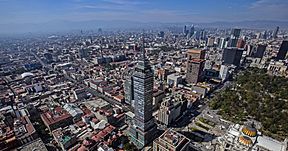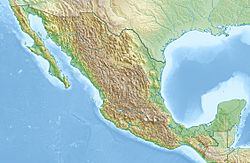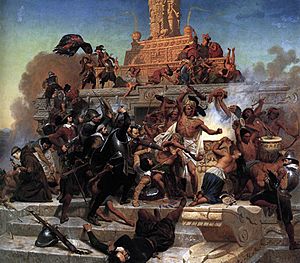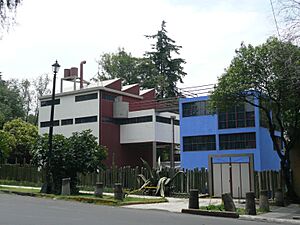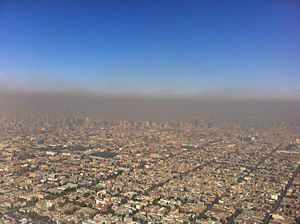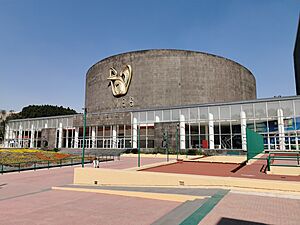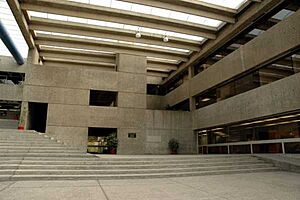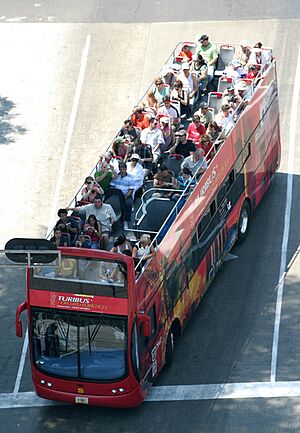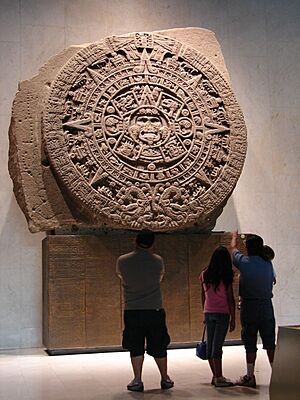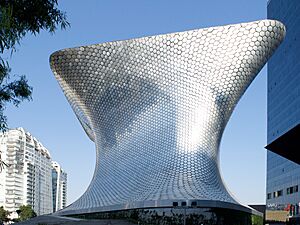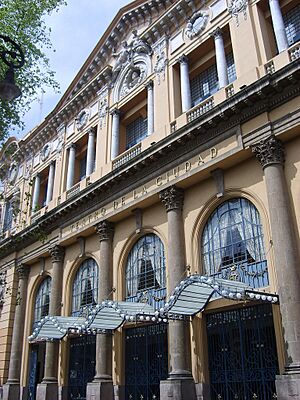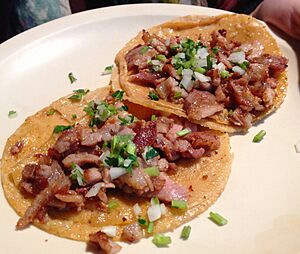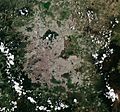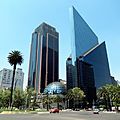Mexico City facts for kids
Quick facts for kids
Mexico City
|
|||
|---|---|---|---|
|
Skyline of Mexico City with the Torre Latinoamericana
Museo Soumaya
Paseo de la Reforma from the Chapultepec Castle
Cathedral and National Palace in the Zócalo
Santa Fe business district
|
|||
|
|||
| Nickname(s):
CDMX
|
|||
| Motto(s):
La Ciudad de los Palacios
(The City of Palaces) |
|||
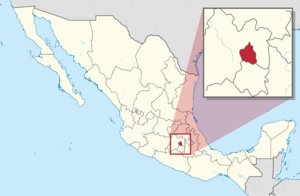
Mexico City within Mexico
|
|||
| Country | |||
| Founded |
|
||
| Founded by |
|
||
| Area | |||
| • Total | 1,485 km2 (573 sq mi) | ||
| Ranked 32nd | |||
| Elevation | 2,240 m (7,350 ft) | ||
| Highest elevation
(Ajusco)
|
3,930 m (12,890 ft) | ||
| Population
(2020)
|
|||
| • Total | 9,209,944 | ||
| • Rank | 1st in North America 1st in Mexico |
||
| • Density | 6,202.0/km2 (16,063/sq mi) | ||
| • Density rank | 1st | ||
| • Metro area | 21,804,515 | ||
| Demonyms |
|
||
| GDP | |||
| • Federal District | US$212 billion (2021) | ||
| • Greater Mexico City | US$340 billion (2021) | ||
| Time zone | UTC−06:00 (CST) | ||
| Postal code |
00–16
|
||
| Area code | 55/56 | ||
| ISO 3166 code | MX-CMX | ||
| Patron Saint | Philip of Jesus (Spanish: San Felipe de Jesús) | ||
| HDI | |||
| Official name: Historic center of Mexico City, Xochimilco and Central University City Campus of the UNAM | |||
| Type: | Cultural | ||
| Criteria: | i, ii, iii, iv, v | ||
| Designated: | 1987, 2007 (11th, 31st sessions) | ||
| Reference #: | 412, 1250 | ||
| Region: | Latin America and the Caribbean | ||
| b. Area of Mexico City that includes non-urban areas at the south | |||
Mexico City (Spanish: Ciudad de México, or CDMX) is the capital and largest city of Mexico. It is also the most populated city in North America. Mexico City is a very important place for culture and money in the world.
The city is in the Valley of Mexico, high up on a plateau. It is about 2,240 meters (7,350 feet) above sea level. The city has 16 areas called boroughs, which are divided into smaller neighborhoods.
In 2020, about 9.2 million people lived in the city itself. If you include the areas around it, called Greater Mexico City, the population is over 21.8 million. This makes it one of the largest city areas in the world. It is also the biggest Spanish-speaking city.
Mexico City is the oldest capital city in the Americas. It is one of only two capital cities founded by Indigenous people.
Contents
History
Early History and Aztec Beginnings
The first signs of people living in the Mexico City area are very old. Some remains, like the "Peñon woman," are about 12,700 years old. This makes them some of the oldest human remains found in the Americas.
Later, groups like the Toltec and Mexica (Aztecs) came to this area. The Mexica people arrived around the 1300s. They settled on islands in the middle of a lake system.
Founding of Tenochtitlan
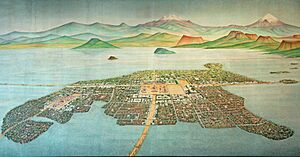
The city of Mexico-Tenochtitlan was founded by the Mexica people in 1325 or 1327. It was built on an island in Lake Texcoco. A smaller city-state called Tlatelolco was also nearby.
A legend says that the Mexica's main god, Huitzilopochtli, told them where to build. He said to look for a golden eagle on a prickly pear cactus eating a rattlesnake. This is why the eagle and snake are on the Mexican flag today.
Between 1325 and 1521, Tenochtitlan grew very strong. It became the center of the Aztec Empire. This empire reached from the Gulf of Mexico to the Pacific Ocean.
Spanish Conquest and New City
In 1519, Spanish explorer Hernán Cortés arrived. He marched to Tenochtitlan with help from other native groups. The Aztec ruler, Moctezuma II, greeted them.
But soon, things turned bad. Cortés put Moctezuma under house arrest. On June 30, 1520, the Aztecs fought back. This event is known as "La Noche Triste" (The Sad Night). The Aztecs pushed the Spanish out.
Cortés came back in May 1521 and started a siege. For three months, the city suffered from no food or water. Many also got smallpox, a disease brought by the Europeans. The Spanish destroyed much of Tenochtitlan during the fighting.
After the conquest, Cortés decided to rebuild the city. He renamed it "Mexico" because it was easier for the Spanish to say. They built Catholic churches on top of old Aztec temples.
Growth of Colonial Mexico City
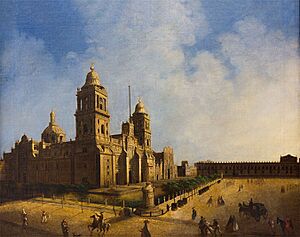
Mexico City became the capital of New Spain. The Spanish built their main square, the Zócalo, where the Aztec ceremonial center used to be. The Metropolitan Cathedral was built there too.
Many indigenous people were forced to work on rebuilding the city. A friar named Toribio de Benavente Motolinia described it as a "plague" because so many people worked and died.
The city was built on a grid pattern, like many Spanish cities. The Spanish lived closer to the main square. Indigenous people lived outside this area.
Because the city was built on a lake, it often flooded. Workers had to drain the lake to prevent this. This helped with health but changed the environment.
Mexico City became rich from trade. It was easy to connect with both the Atlantic and Pacific oceans. Many wealthy families built grand palaces, earning the city the nickname "The City of Palaces."
Independence and Challenges
The Mexican War of Independence began in 1810. After ten years of war, Mexico declared independence from Spain in 1821. Mexico City became the capital of the new country.
The city saw many political fights in the 1800s. It was occupied by American troops during the Mexican–American War (1847–1848). The Battle for Mexico City included fighting at Chapultepec Castle. Young cadets, known as Los Niños Héroes (the "Boy Heroes"), bravely defended the castle.
Modernization and Revolution
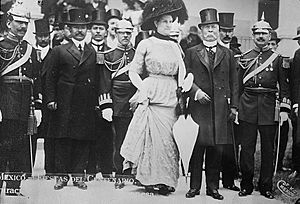
During the rule of President Porfirio Díaz (1876–1911), Mexico City grew a lot. It got modern roads, schools, and transportation. Díaz wanted the city to look like grand European cities, especially Paris. Many beautiful buildings were constructed during this time.
However, the rest of the country remained poor. This led to the Mexican Revolution in 1910. Mexico City mostly avoided the worst violence. One important event was the "Decena Trágica" in 1913. This was a coup against the elected government.
20th Century Growth and Changes
In the 20th century, Mexico City grew incredibly fast. In 1900, it had about 500,000 people. By 1980, it had nearly 9 million. This growth led to new challenges.
The Ciudad Universitaria, Mexico City, the main campus of the National Autonomous University of Mexico, was built in the 1950s. It features amazing buildings and murals by famous artists like Diego Rivera. It is now a World Heritage Site.
The 1968 Summer Olympics brought new sports facilities. In 1969, the Mexico City Metro subway system opened.
Rapid growth caused problems like air pollution and water pollution. Many people from the countryside moved to the city, creating large informal settlements.
In 1985, a big earthquake hit the city. It caused a lot of damage. Citizens had to organize their own rescue efforts because the government was slow to respond.
Later, in 1997, Cuauhtémoc Cárdenas became the first elected mayor of Mexico City. This was a big step towards more democratic government in the city.
Environment
Lake System and Water Management
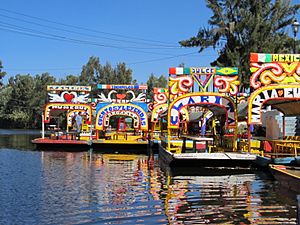
Long ago, much of the valley was covered by Lake Texcoco. The Aztecs built dikes to manage the water. But these dikes were destroyed during the Spanish conquest.
The Spanish later drained the lake to prevent floods. Today, only a small part of the original lake remains. There are plans to bring back more natural water sources to the valley.
Air Quality and Pollution Control
In the 1990s, Mexico City was known for its bad air pollution. But the city has worked hard to clean it up. Pollution levels have dropped a lot since then.
The government has put in place many plans to help. They check air quality often and close factories when pollution is too high. They also have a program called A day without a car, where cars can't drive on certain days.
New cars must have special filters to reduce pollution. Public transport like the Metrobús (bus rapid transit) and Ecobici (bike-sharing) also help.
Parks and Recreation
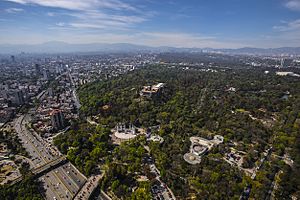
Chapultepec is the city's most famous public park. Aztec emperors used it as a retreat. Today, it has the Chapultepec Zoo, several ponds, and seven museums. This includes the National Museum of Anthropology.
Other well-known parks are the Alameda Central, the oldest public park in the Americas. There are also Parque México and Parque España in the Condesa district.
Mexico City has three zoos: Chapultepec Zoo, the San Juan de Aragon Zoo, and Los Coyotes Zoo. They have many different animals, including some that are endangered.
Six Flags México is a large amusement park in the city. In winter, the main square, the Zócalo, turns into a giant ice skating rink.
Climate
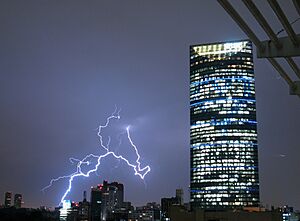
Mexico City has a subtropical highland climate. This means it's tropical but high up, so it's not too hot. The average temperature is between 12 and 16 degrees Celsius (54 to 61 degrees Fahrenheit). It rarely gets very cold or very hot.
Most of the rain falls from May to October. The rest of the year is drier and sunnier. Snow is very rare in the city itself. The last time it snowed a lot was in 1967.
| Climate data for Mexico City (Tacubaya), 1991–2020 normals, extremes 1877–2018 | |||||||||||||
|---|---|---|---|---|---|---|---|---|---|---|---|---|---|
| Month | Jan | Feb | Mar | Apr | May | Jun | Jul | Aug | Sep | Oct | Nov | Dec | Year |
| Record high °C (°F) | 28.2 (82.8) |
30.8 (87.4) |
32.9 (91.2) |
34.2 (93.6) |
33.9 (93.0) |
33.5 (92.3) |
29.6 (85.3) |
29.4 (84.9) |
28.6 (83.5) |
29.2 (84.6) |
31.5 (88.7) |
29.4 (84.9) |
33.9 (93.0) |
| Mean daily maximum °C (°F) | 22.3 (72.1) |
24.2 (75.6) |
26.0 (78.8) |
27.3 (81.1) |
27.1 (80.8) |
25.7 (78.3) |
24.4 (75.9) |
24.5 (76.1) |
23.6 (74.5) |
23.3 (73.9) |
22.7 (72.9) |
22.3 (72.1) |
24.5 (76.1) |
| Daily mean °C (°F) | 15.7 (60.3) |
17.1 (62.8) |
18.9 (66.0) |
20.4 (68.7) |
20.9 (69.6) |
19.9 (67.8) |
18.8 (65.8) |
19.1 (66.4) |
18.6 (65.5) |
18.0 (64.4) |
16.4 (61.5) |
15.5 (59.9) |
18.3 (64.9) |
| Mean daily minimum °C (°F) | 8.4 (47.1) |
9.4 (48.9) |
11.1 (52.0) |
13.0 (55.4) |
13.7 (56.7) |
13.8 (56.8) |
13.0 (55.4) |
13.1 (55.6) |
13.1 (55.6) |
11.8 (53.2) |
9.8 (49.6) |
8.4 (47.1) |
11.5 (52.7) |
| Record low °C (°F) | −4.2 (24.4) |
−4.4 (24.1) |
−4.0 (24.8) |
−0.6 (30.9) |
3.7 (38.7) |
0.0 (32.0) |
1.0 (33.8) |
1.0 (33.8) |
1.0 (33.8) |
0.0 (32.0) |
−3.0 (26.6) |
−3.0 (26.6) |
−4.4 (24.1) |
| Average precipitation mm (inches) | 12.5 (0.49) |
5.9 (0.23) |
11.7 (0.46) |
24.9 (0.98) |
62.5 (2.46) |
137.1 (5.40) |
177.1 (6.97) |
175.1 (6.89) |
160.2 (6.31) |
71.2 (2.80) |
17.6 (0.69) |
5.0 (0.20) |
860.8 (33.89) |
| Average precipitation days (≥ 0.1 mm) | 1.9 | 1.2 | 2.2 | 4.3 | 8.2 | 13.1 | 17.2 | 16.9 | 14.4 | 7.2 | 2.0 | 0.6 | 89.2 |
| Average relative humidity (%) | 54.0 | 48.0 | 43.5 | 45.2 | 52.8 | 63.7 | 69.6 | 69.2 | 69.9 | 64.0 | 57.1 | 55.3 | 57.7 |
| Mean monthly sunshine hours | 233.4 | 232.5 | 262.3 | 238.6 | 232.2 | 180.9 | 178.6 | 176.9 | 148.3 | 190.9 | 224.4 | 226.9 | 2,525.8 |
| Source 1: Servicio Meteorologico Nacional | |||||||||||||
| Source 2: World Meteorological Organization (humidity and sun 1981–2010) | |||||||||||||
Demographics
| Historical population | ||
|---|---|---|
| Year | Pop. | ±% |
| 1950 | 3,365,081 | — |
| 1960 | 5,479,184 | +62.8% |
| 1970 | 8,830,947 | +61.2% |
| 1980 | 13,027,620 | +47.5% |
| 1990 | 15,642,318 | +20.1% |
| 2000 | 18,457,027 | +18.0% |
| 2010 | 20,136,681 | +9.1% |
| 2019 | 21,671,908 | +7.6% |
| for Mexico City Agglomeration: | ||
The Valley of Mexico has always been a busy place. In 1921, Mexico City had less than a million people. Today, the city itself has about 9.2 million residents.
The city's growth has spread beyond its official borders. It now includes 59 towns in the State of Mexico and one in Hidalgo. This larger area is called Greater Mexico City.
Greater Mexico City and Megalopolis
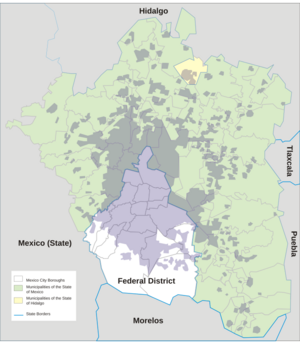
Greater Mexico City is the largest city area in the country. It has about 21.8 million people. Most of these people live in Mexico City proper or in nearby towns like Ecatepec and Nezahualcóyotl.
This large area is part of an even bigger region. It's called the Corona regional del centro de México or Mexico City megalopolis. This huge area has over 33.4 million people. It includes other major cities like Puebla and Querétaro.
The growth of Greater Mexico City has slowed down. This is partly because the government wants to reduce pollution. People are also moving from the city center to the outer suburbs.
Religion in Mexico City
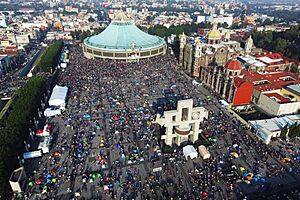
Most people in Mexico City (82%) are Catholic. This is a bit lower than the national average. Other religions are also practiced, like different types of Protestant groups, Jewish communities, and Islamic groups.
There are also many people who do not follow a religion. The patron saint of Mexico City is Saint Philip of Jesus. He was a Mexican Catholic missionary.
Diverse Ethnic Groups
Mexico City is a very diverse place. About 18.74% of the population are indigenous peoples. They come from different parts of Mexico. They often move to the capital for better jobs.
Common indigenous languages spoken include Nahuatl, Otomi, and Zapotec. About 2.03% of the city's population identifies as Black or of African descent.
The city is also home to many people from other countries. There are large communities from the United States, Canada, and South America. Many people also come from Europe and the Arab world. Mexico City has the largest population of Americans living outside the United States.
Health
Mexico City has some of the best hospitals in Mexico. These include private hospitals like Hospital Ángeles. There are also large public healthcare facilities. The IMSS has its biggest centers here.
The city has worked to improve air quality. They have updated public transport and made rules for new cars. All new cars must have a catalytic converter to reduce pollution. Trucks must use cleaner fuel.
The underground rail system was started in 1968. It helps reduce both air pollution and traffic congestion. It carries over 5 million people every day. These efforts have made the air quality much better than it was in 1991.
Education
Public schools in Mexico City are managed by the federal Secretariat of Public Education. The city's public high school system is called IEMS-DF.
The city has many public and private schools. There are also international schools for Mexican and foreign students. Some well-known ones are the German, Japanese, French, and American schools.
The Colegio de Santa Cruz de Tlatelolco is a very old school. It was the first European school of higher learning in the Americas.
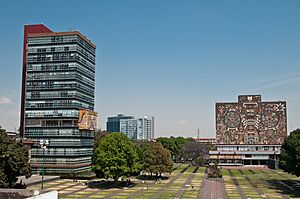
The National Autonomous University of Mexico (UNAM) is in Mexico City. It is the largest university in the Americas. It has over 300,000 students. Many important people, including Nobel winners and presidents, have studied there.
UNAM does half of Mexico's scientific research. Its main campus, Ciudad Universitaria, is a UNESCO World Heritage Site.
Other major universities include the National Polytechnic Institute (IPN) and the Metropolitan Autonomous University (UAM).
Tourism
Mexico City is a popular place for tourists. The Historic center of Mexico City and the "floating gardens" of Xochimilco are World Heritage Sites.
In the Historic Center, you can see the Plaza de la Constitución (Zócalo). This main square has the Metropolitan Cathedral and the National Palace. You can also see ancient Aztec temple ruins like Templo Mayor.
The golden Angel of Independence is a famous symbol of the city. It is on the wide avenue Paseo de la Reforma. This avenue was designed to connect the National Palace with the Castle of Chapultepec. Today, it is an important financial area.
Chapultepec Park has the Chapultepec Castle, which is now a museum. It also has many other museums, monuments, and the national zoo. The National Museum of Anthropology is here. It holds the famous Aztec Calendar Stone.
The Palacio de Bellas Artes is a beautiful white marble building. It is a theater and museum. Its construction started long ago and finished in 1934.
The Plaza de las Tres Culturas is another important site. It has ancient ruins, a colonial church, and modern buildings. The Basilica of Our Lady of Guadalupe is also a very important religious site.
Mexico City has about 170 museums, over 100 art galleries, and about 30 concert halls. Many places have murals painted by Diego Rivera. His house and his wife Frida Kahlo's house are now museums.
Culture
Art and Creativity
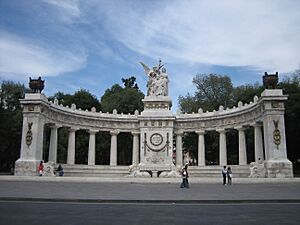
Mexico City has a long history of artistic expression. From ancient times, people created beautiful art. Much of the early indigenous art was destroyed during the Spanish conquest.
During colonial times, art was mostly religious. The Metropolitan Cathedral has works by famous artists. The bronze horse statue of Charles IV of Spain, called El Caballito, is also from this time.
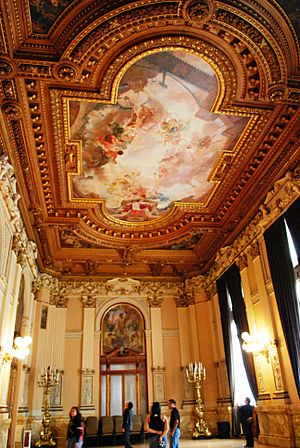
After the Mexican Revolution, a new art movement called muralism began. Famous muralists like José Clemente Orozco, David Alfons Siqueiros, and Diego Rivera painted large murals on city buildings. Frida Kahlo was another very famous Mexican painter. Her house is now a museum.
Museums to Explore
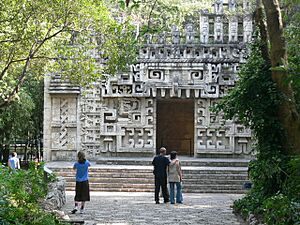
Mexico City has many museums for art. The Museo Tamayo has a collection of international modern art. The Museo de Arte Moderno shows works by Mexican artists from the 20th century.
The Museo Soumaya has a huge private collection of sculptures by Auguste Rodin. It also has works by Salvador Dalí and other masters. The Museo de San Ildefonso is in a beautiful old palace and hosts world-class exhibits.
Most museums are open from Tuesday to Sunday. Many offer free entry on Sundays.
Music, Theater, and Entertainment
Mexico City has many orchestras and music venues. The National Auditorium hosts famous pop and rock artists. It also shows opera performances from New York.
Other places for concerts include the Teatro Metropolitan and the Palacio de los Deportes. The Foro Sol Stadium hosts very large international artists.
The National Center for the Arts has places for music, theater, and dance. UNAM's cultural center (CCU) has a concert hall, theaters, and cinemas.
The José Vasconcelos Library is a national library. The Papalote Museo del Niño (Kite Children's Museum) has a huge dome screen. Six Flags México is the largest amusement park in Latin America.
The Cineteca Nacional (Mexican Film Library) shows many different films. It also hosts film festivals.
Delicious Cuisine
Mexico City is famous for its food. Tacos have been a popular food for a long time. You can find many types of tacos, like tacos de barbacoa.
The city has some of the freshest fish and seafood in Mexico's interior. La Nueva Viga Market is the second largest seafood market in the world.
You can find restaurants specializing in food from all over Mexico. There are also many international restaurants. Some Mexico City restaurants are ranked among the best in the world. Pujol is a famous Mexican avant-garde restaurant.
Images for kids
-
The Paseo de la Reforma is a wide avenue designed by Ferdinand von Rosenzweig in the 1860s and was modeled after the Champs-Élysées in Paris.
-
The Art Nouveau/Neoclassical Palacio de Bellas Artes is the prominent cultural center in the city
-
Televisa headquarters in Mexico City
See also
 In Spanish: Ciudad de México para niños
In Spanish: Ciudad de México para niños


